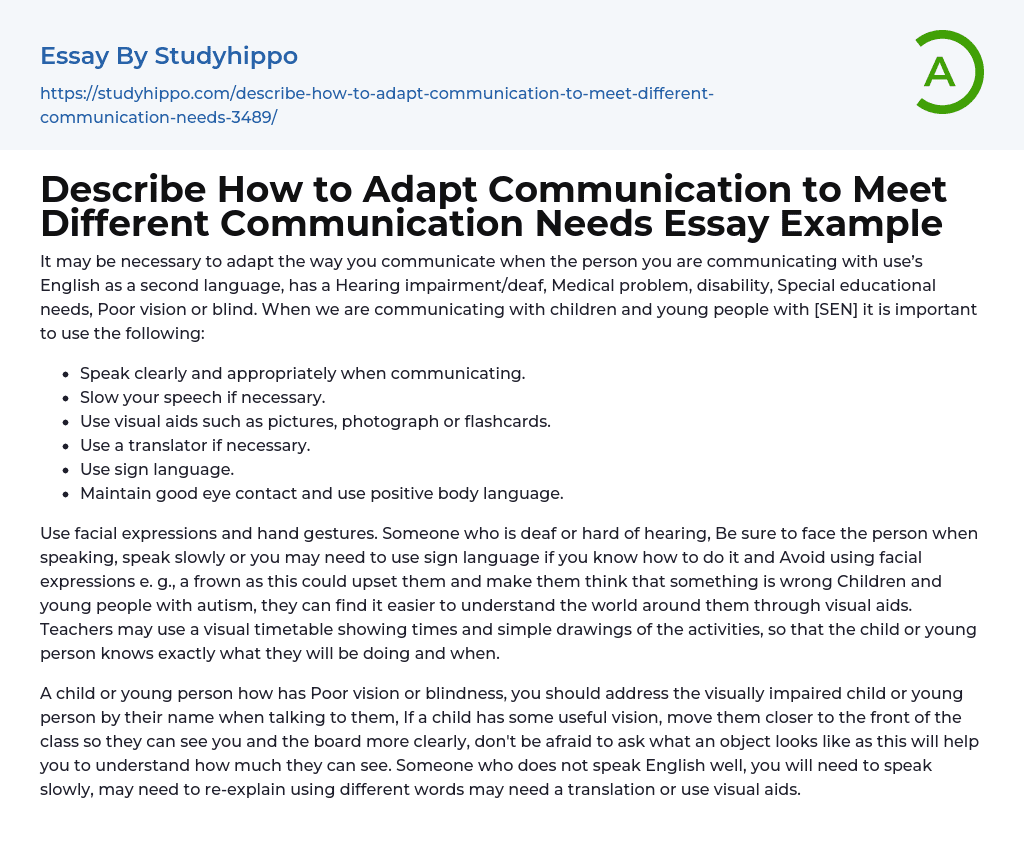

Describe How to Adapt Communication to Meet Different Communication Needs Essay Example
It may be necessary to adapt the way you communicate when the person you are communicating with use’s English as a second language, has a Hearing impairment/deaf, Medical problem, disability, Special educational needs, Poor vision or blind. When we are communicating with children and young people with [SEN] it is important to use the following:
- Speak clearly and appropriately when communicating.
- Slow your speech if necessary.
- Use visual aids such as pictures, photograph or flashcards.
- Use a translator if necessary.
- Use sign language.
- Maintain good eye contact and use positive body language.
Use facial expressions and hand gestures. Someone who is deaf or hard of hearing, Be sure to face the person when speaking, speak slowly or you may need
...to use sign language if you know how to do it and Avoid using facial expressions e. g., a frown as this could upset them and make them think that something is wrong Children and young people with autism, they can find it easier to understand the world around them through visual aids. Teachers may use a visual timetable showing times and simple drawings of the activities, so that the child or young person knows exactly what they will be doing and when.
A child or young person how has Poor vision or blindness, you should address the visually impaired child or young person by their name when talking to them, If a child has some useful vision, move them closer to the front of the class so they can see you and the board more clearly, don't be afraid to ask what an object looks like as this will help you to understand how much the
can see. Someone who does not speak English well, you will need to speak slowly, may need to re-explain using different words may need a translation or use visual aids.
- Greeting essays
- Orality essays
- Intercultural Communication essays
- Interpersonal Communication essays
- Cross-Cultural Communication essays
- Nonverbal Communication essays
- Effective Communication essays
- Communication Skills essays
- Anatomy and Physiology essays
- Addiction essays
- Biodegradation essays
- Dental Care essays
- Disease essays
- Disorders essays
- Health Care essays
- Intelligence Quotient essays
- Nutrition essays
- Olfaction essays
- Public Health essays
- Women's Health essays
- World health organization essays
- Cancer essays
- Infectious Disease essays
- Lung Cancer essays
- Neurology essays
- Physical Exercise essays
- Medicine essays
- Sex essays
- Inquiry essays
- Disability essays
- Poison essays
- Action Potential essays
- Nervous System essays
- Childbirth essays
- Puberty essays
- Blood essays
- Kidney essays
- Neuron essays
- Body essays
- Glucose essays
- Sense essays
- Heart essays
- Skeleton essays
- Human Physiology essays
- Eye essays
- Immune System essays
- Muscle essays
- Skin essays
- Brain essays
- Central Nervous System essays



